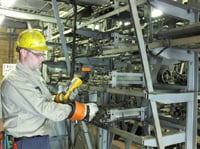
Pittsburgh-based The Techs Industries, a subsidiary of Steel Dynamics Inc., produces high-quality, hot-dip galvanized steel sheet metal. The Techs is divided into three parts - MetalTech, GalvTech, and NexTech - each specializing in a different ranges of gauges and widths. The oldest of the three, MetalTech, produces the thickest galvanized steel sheet, from 0.040 to 0.130 inches thick and 24 to 50 inches wide. The Techs was acquired by Steel Dynamics in 2007.
Steve Toward is one of nine maintenance technicians at MetalTech, where he takes care of electrical equipment of all kinds, including the 250 Vdc motors that date to the plant's opening in the early 1950s. With equipment of that age Toward finds his Fluke 1587 Insulation Multimeter a great help.
Checking on a regular basis
Whenever a piece of equipment comes back from a rebuild it gets a full set of insulation resistance readings, which are put in the history file for that unit and used as a reference for later measurements. Some items are checked more frequently than others, but the motors get special attention.
The 250 Vdc motors that drive the machinery range in size from 25 to 200 hp, and each is driven by its own motor-generator set. Once a year the company shuts down for a week or two to check and, where needed, rebuild equipment all over the plant. "We'll disconnect the motors," says Toward. "Any of the ones that have bad bearings or if we take readings and they're out of whatever range is specified for them, we'll have them sent out, rebuilt, tested and rebuilt, whatever the case may be, by a contractor." Similar tests are also run on the plant conductors, "wiring runs, cables, anything that you would be testing insulation on."
Motor and wiring insulation aren't the only things that needs its resistance measured. The plant has plenty of old open contactors, and Toward uses his 1587 to check the insulation resistance of the coils; he also uses the 1587's low ranges to check the resistance of the contact themselves.
Finding the leaks
Toward got his 1587 about a year ago, after convincing management that the plant's old hand-cranked insulation tester had outlived its usefulness. And he hadn't had the 1587 long when he started finding problems he hadn't noticed before - things like leaks to ground in some of the plant wiring. "We were getting a ghost ground," he explains, "trying to figure out why voltages are…not what they should be, lower or higher voltages on different legs of some of the equipment. And just by isolating some of the conductors and doing the insulation test on it, we were able to find out that there was leakage current."
Toward recalls one problem that couldn't have been solved with anything but an insulation tester. One of the plant's generators was putting out the wrong voltage. He took it out of service, hooked up the 1587 and found that one winding was just beginning to go bad. "Now if you would have used just a regular resistance meter," he says, "you would not have seen that, but with the 1000 volt test on that we were able to find that."